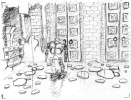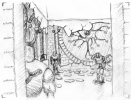

















 Scenario
Scenario 
A mechanical-looking "guy" (that's the main character) finds himself lying on a box in a brighly lit, minimalistic, box-shaped room. He looks around, the room has no doors or windows, actually there's no exit at all. Puzzled, he sits back on the box; the box suddenly falls apart into pieces. The guy takes one piece (it's pretty heavy), thinks a bit and suddenly throws it at the wall - well, what else should he do? The character runs to the wall to see the hole broken out. Outside some architectural details can be seen, like a wall of an old building. The guy tries to break out a larger hole; he can't. After several seconds the hole disappears - the walls are back in place, like nothing would have happened.
The guy feels strange. Where is he? What is this room? Why the walls restore themselves? Why there's no exit?
After a few moments of thinking, the character realizes that he has some "power" inside. There's some sort of "electricity" inside him, and he can actually control it! He concentrates and launches a bolt of electricity at the wall. Then another one. Then waits a few seconds on purpose now - like before, the holes in the walls disappear. This time he had noticed more details outside - it seems like his room/box would be surrounded by ancient walls. Tries more ways to overcome the walls at another place and notices even more details. The walls still restore themselves though.
The character notices that he has changed - his mechanical parts aren't as shiny as before...
The guy thinks, then "invents" another attack, this time more powerful, aimed at the longer wall. Quite a bit of it fractures into pieces. It still does restore itself though, but that already doesn't bother him; he just takes a look at the old wall outside. He has changed again a bit.
Slowly, the character walks towards the center of the room. He begins his final attempt slowly and accelerates, turning around like a whirlwind. A field of "force" forms around him; then the guy stops, launching the field all around. All the walls are blown up into pieces that slowly settle down on the floor. He looks around. It's an ancient building with lots of architectural details; the postaments and the pillars and the ornaments and the statues.
He turns his head.
On the other side there's a door.
The character rushes towards the door, opens it and finds another room out there. There's another guy; they look at each other in surprise. Another guy walks in through the other doors.
Blur out. Credits and fun part. Interactive mode.
Credits and fun part
After the whole story is over, the credits and some other long textual info in scroller style are presented. At the same time, the main character performs some animations. We think that "funny" animations, like the guy launching balloons or dancing, would improve the user's experience in otherwise "serious" story.
Interactive mode
During interactive mode, the user can directly control the main character - walk around the room and launch electricity bolts and possibly other "spells" at the walls. The walls fracture on hit, the pieces fly out and settle on the floor according to the laws of physics, and after some time the holes in the walls disappear (like in original story). The interactive mode enables the user to take a closer look at the details (esp. architecture of the other walls) and possibly have some fun with realtime fracture physics. And of course, interactivity justifies why all this story is realtime rendering (as opposed to prerendered animation).
Explanation(s)
What all this is supposed to mean is open to the interpretation! :)
We did not base the story on "technology (that dissolves the boundaries)" like in whole ImagineCup2005 theme. The Rendering invitational theme is just that - "dissolving (of) boundaries", and we did base our story only on that.
 Storyboard
Storyboard 
During inception of concept we decided to do the work in iterative way. We didn't do lots of 'traditional sketches' (i.e. colorful drawings of the full scenes) - instead we made a couple of sketches, written detailed scenario on the paper and made the animation directly. We'd do a bit of animation, discuss it, possibly adjust and tweak it, then proceed to the next bit. This way we could see how the animation actually looks in 3D and make the adjustments if necessary. Additionally we made detailed blueprints of separate characters/objects that would be directly suitable for modeling.
This iterative workflow proved to be successful so far - in realtime rendering there so many technical details and constaints that you can't go the "waterfall" approach (sketches, then implementation, then testing).
Below are excerpts from the scenario, each illustrated by sketches or screenshots directly from the realtime rendering. Screenshots are not final, as wall fracture, physics and some special effects are still in development. You can click on any thumbnail to see the full image.
Finds himself lying on a box in a box-shaped room:
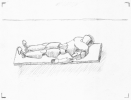
Sits back on the box; the box suddenly falls apart into pieces:
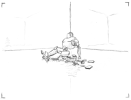
Takes one piece and throws it at the wall:
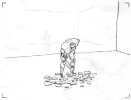
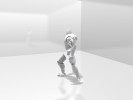
Runs to the wall to see the hole broken out. Outside some architectural details can be seen:
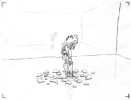
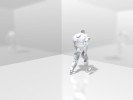
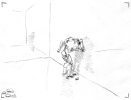
Tries to break out a larger hole; he can't. After several seconds the hole disappears:
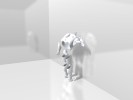
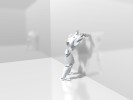
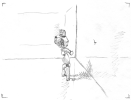
After a few moments of thinking, the character realizes that he has some "power" inside:
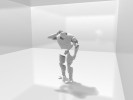
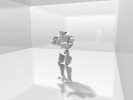
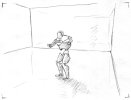
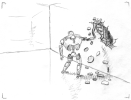
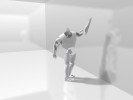
The character notices that he has changed:
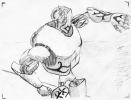
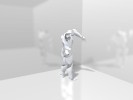
Another attack, more powerful, aimed at the longer wall:
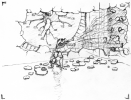
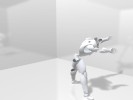
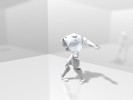
Final attempt <...> turning around like a whirlwind <...> he stops, launching the field all around:
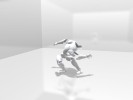
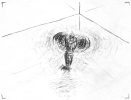
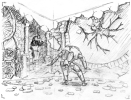
Rushes towards the door, opens it and finds another room out there:
